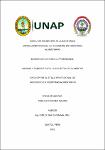| dc.contributor.advisor | Díaz Sangama, Emilio | |
| dc.contributor.author | Paredes Galvez, Carlos | |
| dc.date.accessioned | 2022-12-15T18:50:15Z | |
| dc.date.available | 2022-12-15T18:50:15Z | |
| dc.date.issued | 2022 | |
| dc.identifier.uri | https://hdl.handle.net/20.500.12737/8622 | |
| dc.description.abstract | The present work on aromas and flavors in the food industry has the objective of knowing how to define between aroma and flavor and to know the mechanism of its formation of these aromas from both microorganisms that can be fungi, bacteria, yeasts, generating different odors or aromas. natural that have the same characteristics that do not alter the quality of food products, maintaining the taste, bitter, acid, sweet and umami, which are generated by chemical substances that are generated by olfactory sensations present in the nose and mouth of every human being . Likewise, when a person is older, they lose that ability to be a good evaluator, because a young person has all the sensitive endings in the tongue and nose, making it, and if they are a trained person, a good evaluator. The food industry currently has a great challenge which is to produce aromas and flavors using natural raw materials, thus having functional, healthy food products, with all their nutritional chemical compounds, that the human body can take advantage of completely healthy. This industry worldwide is the one that has grown the most in the last decade, and we must know how to take advantage of it for its use in the improvement of products that improve people's lives as well as improve the quality of life of the human being, in that way. contribute to the disappearance of synthetic products that do not contribute anything good to the human body. | en_US |
| dc.description.abstract | El presente trabajo sobre aromas y sabores en la industria alimentaria tiene el objetivo de conocer definir entre aroma y sabor y conocer el mecanismo de su formación de estos aromas a partir tanto de microorganismos que pueden ser hongos, bacterias, levaduras, generando diferentes olores u aromas naturales que tienen las mismas características que no alteran la calidad de productos alimenticios, manteniendo el sabor, amargo, acido, dulce y umami, los cuales son generados por sustancias químicas que son generados por sensaciones olfativas presentes en la nariz y boca de todo ser humano. Así mismo una persona cuando tiene edad avanzada va perdiendo esa capacidad de ser un buen evaluador, porque una persona joven tiene todas las terminaciones sensibles en la lengua y la nariz, haciéndolo y si es un apersona entrenada un buen evaluador. La industria alimentaria tiene en estos momentos un gran reto la cual es producir aromas y sabores usando materias primas naturales, así tener productos alimenticios funcionales, saludables, con todos sus compuestos químicos nutricionales, que el cuerpo humano lo aproveche totalmente sano. Esta industria a nivel mundial es la que más crecimiento esta teniendo en esta última década, y hay que saber aprovecharlo para su utilización en la mejora de productos que mejoren la vida de las personas así mismo mejorar la calidad de vida del ser humano, de esa manera contribuir a la desaparición de productos sintéticos que no contribuyen con nada bueno al cuerpo humano. | es_PE |
| dc.format | application/pdf | es_PE |
| dc.language.iso | spa | es_PE |
| dc.publisher | Universidad Nacional de la Amazonía Peruana | es_PE |
| dc.rights | info:eu-repo/semantics/openAccess | * |
| dc.rights.uri | https://creativecommons.org/licenses/by/4.0/ | * |
| dc.subject | Tecnología de alimentos | es_PE |
| dc.subject | Aromatizantes | es_PE |
| dc.subject | Conceptos fundamentales | es_PE |
| dc.title | Aromas y sabores para la industria de alimentos | es_PE |
| dc.type | info:eu-repo/semantics/bachelorThesis | es_PE |
| thesis.degree.discipline | Ingeniería en Industrias Alimentarias | es_PE |
| thesis.degree.grantor | Universidad Nacional de la Amazonía Peruana. Facultad de Industrias Alimentarias | es_PE |
| thesis.degree.name | Ingeniero(a) en Industrias Alimentarias | es_PE |
| dc.subject.ocde | https://purl.org/pe-repo/ocde/ford#2.11.01 | es_PE |
| renati.author.dni | 71562354 | |
| renati.advisor.orcid | https://orcid.org/0000-0002-5424-0937 | |
| renati.advisor.dni | 05222152 | |
| renati.type | https://purl.org/pe-repo/renati/type#trabajoDeSuficienciaProfesional | es_PE |
| renati.discipline | 721046 | es_PE |
| renati.level | https://purl.org/pe-repo/renati/level#tituloProfesional | es_PE |
| renati.juror | Arévalo del Aguila, Segundo | |
| renati.juror | Flores Garazatua, Juan Alberto | |
| renati.juror | Urro Rodriguez, Giorgio Sergio | |
| dc.publisher.country | PE | es_PE |


